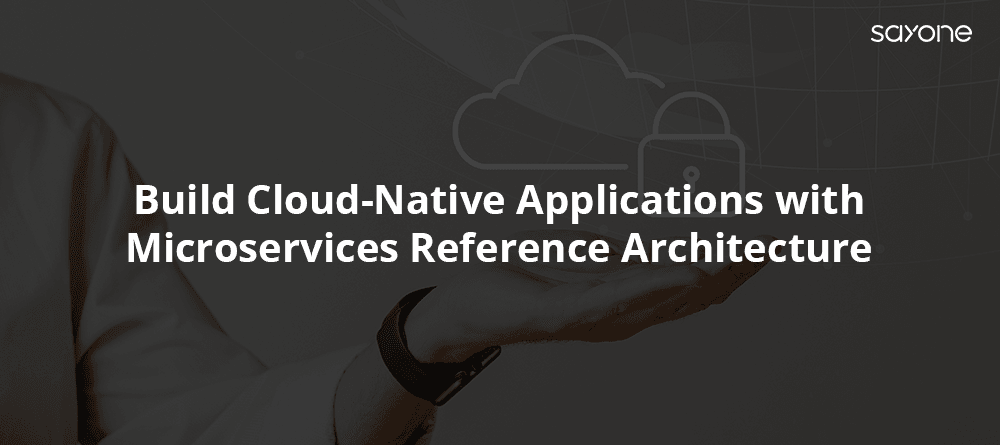
Subscribe to our Blog
We're committed to your privacy. SayOne uses the information you provide to us to contact you about our relevant content, products, and services. check out our privacy policy.

Hari KrishnaOctober 20, 20218 min read

Generating table of contents...
Many enterprises around the world have recognized the value of cloud computing and are migrating to cloud-native architecture in order to keep up with new technologies and supply digital services quickly and efficiently.
The pandemic has empowered cloud-native to flourish on a massive scale. The corporate world's technical answer to the COVID-19 dilemma is centered on cloud computing. As a result, the focus of tech leaders is turning away from reacting to the 'new normal' and toward preparing for the “next normal.” Cloud-native, containers and serverless will continue to attract enterprise customers' attention.
Since cloud-native applications propel dynamism, microservices architecture is a great fit for development. With microservices, the developers create a single application with a series of small services. Each service is self-contained and connects with other microservices over HTTP or other lightweight protocols. It is possible for separate developers to write distinct services in different languages. It's also feasible to deploy each service on its own server.
Learn more about data inconsistencies in micorservices. Read our latest blog titled “Microservices Database Management – What You Should Know”.
According to an IDC study, microservices on cloud platforms will account for 90% of app development by 2022. It is a smart move to always stay up to date with the technology, in order to always stay relevant in the market. In this blog, we will shed some light on what is Microservices Reference Architecture, and how you can leverage it to build state-of-the-art cloud-native mobile applications and cloud-native web applications.
People have high expectations of the apps they use on a regular basis, whether it's a website or a mobile app. As a result, businesses must release new features and repairs on a regular basis. This procedure used to be difficult because an application was often written, built, and released as a single, monolithic application.
You don't have to rewrite your entire codebase to add or modify a feature because microservices work with loosely linked services. At a time, you only make changes to one feature. You can get your software and services to market faster if you break them down into smaller portions that can be tested and deployed separately.
Businesses that use microservices benefit from more efficient teams. Microservices are applications that are broken down into a series of small, self-contained services. Microservices are naturally aligned with agile principles that foster end-to-end team ownership because they are designed to act independently.
Another advantage is the ease of deployment. To simplify the application change-management process, each microservice is designed and centered around a business function. Time to market is faster since each service is separately modified, tested, and delivered without affecting other services.
Download and read our ebook titled “Choose the best microservices vendor and trim the costs” before starting your microservices journey.
Using a microservices strategy, you can ensure that you have the necessary tools for the job. Microservices development teams can make the best technology selections for the project. They can try out new technologies, libraries, languages, and frameworks more quickly, resulting in shorter innovation cycles.
Improved application quality is another advantage. Functional and performance testing are easier for microservices than monolithic programs because of their "divide-and-conquer" methodology. Because components may be tested in isolation and integrated with a whole or virtualized set of microservices, the microservices architecture lends itself to test-driven development.
Microservices thus improve the overall quality of the application.
Building Cloud-Native Applications with Microservices
When you start designing your cloud-native mobile or web application, there are a few things you must keep in mind:
1. One Service, One Job
Each of the microservices should be focused on a particular task. Each service is smaller, more manageable, and easier to build, maintain, and update. This notion is known as the "single responsibility principle" by Robert Martin, the author of ‘Clean Code.’
2. Separate, Independent Processes
REST APIs and message brokers are required for communication between microservices. All communication between services takes place through the service API of the cloud provider or a communication pattern between services such as Hohpe's Claim Check Pattern.
Want to reorganize your legacy software into microservices? Talk to us today!
3. Continuous Integration and Deployment
Each microservice has the ability to be continuously integrated (CI) and delivered (CD). When you design a large application with several services, you quickly notice that each service evolves at a distinct rate. Each service can move at its own pace if it has its own continuous integration or continuous delivery pipeline. Different components of the system are released at the speed of the slowest moving part of the system in the monolithic method.
4. Resilient Development
Each microservice can be configured for high availability and clustering. Another conclusion you'll have while building huge systems is that when it comes to clustering, one size does not fit all.
The monolithic method of scaling all monolithic services at the same level can result in service overuse or underuse. Worse yet, when shared resources are monopolized, services may suffer. To save resources in a large system, you can deploy services that don't need to scale to a small number of servers. Other services necessitate a large-scale implementation.
Customized Strategy with Microservices Reference Architecture
With a flexible deployment methodology and modernization toolbox, you may tailor your modernization strategy with the microservices reference architecture. Traditional applications can also be gradually moved to the cloud in a cost-effective and business-friendly manner. You may utilize insights to make judgments about what to re-platform, repackage, and rework as you modernize your applications, which will help you save time and money.

An application with a microservices reference architecture is made up of several distinct, network-connected components. The SOA (Services Oriented Architecture) architectural style has evolved into the microservices architectural style. The level of the implemented services is generally fine-grained technical APIs, and applications designed with SOA services tend to become focused on technical integration concerns. Microservices, on the other hand, implements unambiguous business capabilities through finer-grained business APIs.
The most significant distinction between the two approaches is how they are implemented. For many years, applications were packaged in a monolithic manner, which meant that a group of developers built a single huge application that handled everything for a certain business purpose. The application was written and deployed many times across a farm of application servers after it was completed. Microservices, on the other hand, is an architectural style in which developers design and package multiple smaller apps each of which implements only a portion of the larger application.
Let’s understand the specifics of the microservices reference architecture with a diagram.
The public network consists of all the devices and software that run your application. They can be an IoT device, mobile device, or browser.
This public network communicates with the microservices deployed on the cloud via Edge Services. These edge services provide the capability to deliver content through the internet, along with DNS, CDN, firewall, and load balancers.
As you can see, the provider cloud is actually the environment where your application is running, in parts. The container environment includes all the microservices that build your application, along with additional supporting services provided by your cloud vendor.
The enterprise network is your ‘admin portal’ for microservices. From here, you can manage your API endpoints, user directory, and data warehouse.
All of these systems working together in harmony enables you to create a state-of-the-art, agile application that always stays relevant in the market.
Conclusion
Change is the only constant in today's digital business landscape. Companies that rely heavily on their legacy systems will struggle to keep up and will likely lose customers to their more tech-savvy competitors. Innovations and new technologies are introduced at a rapid pace, and companies that rely heavily on their legacy systems will struggle to keep up and will likely lose customers to their more tech-savvy competitors.
Cloud-native web and mobile applications with microservices reference architecture are the perfect solutions for keeping up with ever-changing client needs and swiftly and seamlessly integrating new technologies with your existing systems.
How SayOne Technologies Can Help
As one of the premier application development companies in the US, at SayOne, we offer premier microservices solutions to our clients around the world. Our developers have secured the expertise to help you seamlessly migrate to microservices architecture and move to the cloud platform with minimum disruption of work. Besides, they are adept at building robust new services to meet any specific requirement.
Further, we combine the DevOps and agile methodologies when it comes to building cloud solutions catering to the specific needs of your business. Further, we abide by all international regulations to ensure complete data security.
We have the experience to help businesses in different industry verticals from start-ups and SMBs to large enterprises to transition to microservices architecture. Moreover, we offer flexible engagement models when they choose to hire our developers for their microservices projects.
Are you looking for a versatile microservices vendor? Call us today!

We're committed to your privacy. SayOne uses the information you provide to us to contact you about our relevant content, products, and services. check out our privacy policy.

About Author
Helping Companies Scale Tech Teams 2X Faster with Pre-Vetted Talent | Contract Hiring & Resource Augmentation | Cutting Hiring Costs by 40%

We collaborate with visionary leaders on projects that focus on quality